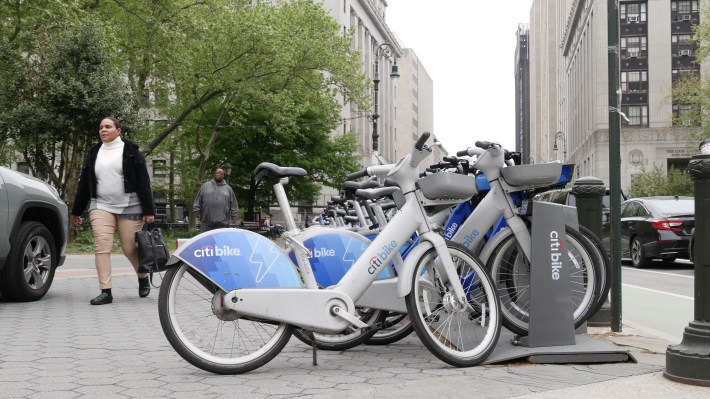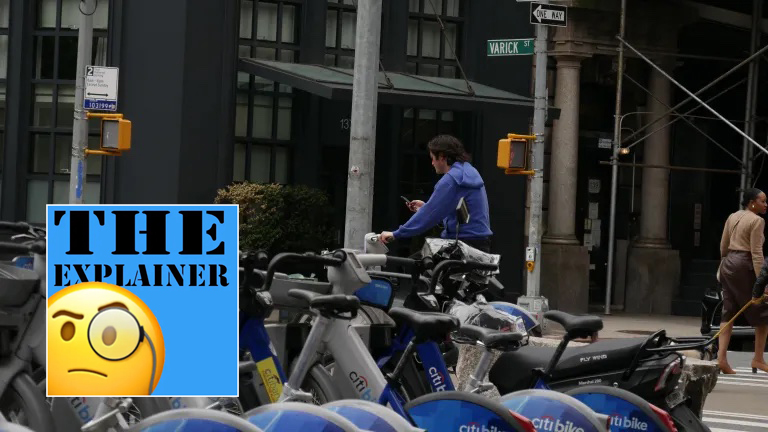At a recent oversight hearing, City Council Member Althea Stevens questioned the need for a Citi Bike dock in her South Bronx district, arguing that she always sees the station full of bicycles.
"If we’re seeing that these stations aren’t being used adequately ... is there another option, can we make the docks smaller?" Stevens asked Department of Transportation leaders at the May 8 plenary.
It's a common refrain — largely on social media — by opponents of the hugely successful transportation service. But a full dock doesn't equate to unused bikes — quite the contrary, according bike-share experts across the country and abroad.
"It’s completely the opposite indicator," David Eddington, the head of Transport for London's bike-share system in the United Kingdom, told Streetsblog. "It’s an indicator that it’s very popular and locations that those bikes are being seen to be filling up the stations, are very popular stations."
You have GOT to be kidding. Citibike is a private company! They are making millions off of this program YOU are hilarious.
— NYC E-Vehicle Safety Alliance (@nyc_evsa) May 17, 2024
The point is that there are far to many buje racks and many are too long.
Why? Citibike huge donor to bike lobby - TA. Period
More than meets the eye
Since its launch in 2013, Citi Bike has grown to become the largest bike-share system in the world outside of East Asia. The system broke another daily ridership record on June 1, logging a whopping 177,319 rides, surpassing the average weekday ridership of the PATH train.
In neighborhoods of Stevens's district, ridership grew 48 percent between 2022 and 2023 — three times as fast as the 16 percent citywide increase, according to Citi Bike's operator, Lyft.
More than two-thirds of riders in those Bronx neighborhoods use Citi Bike's reduced fare program, which offers monthly passes at $5 instead of $18.33 for NYCHA residents and people with SNAP benefits, the company said.
"Citi Bikes are flowing through the system throughout the day, and so a point-in-time observation that a station is empty or that a station is full isn’t reflective of what ridership we’re seeing," said Citi Bike General Manager Patrick Knoth.

A dock might be full because people commuted into an area during the morning rush, or if Lyft has moved bikes to popular stations ahead of busy ridership times, also known as "rebalancing." Knoth cautioned against using a photo from one moment in time as a verdict on Citi Bike's usage.
"Those locations may look full to the naked eye, but it’s actually very intentional," said Edward Inlow, CEO of Shift Transit, which runs bike-share systems in Toronto and Detroit and partners with Lyft in Chicago.
"There’s a lot of different reasons stations can be full, but lack of utilization is not usually one of them."
The commuter crunch frequently hits riders struggling to find a space in busy areas like Lower Manhattan after the morning rush, as Streetsblog has detailed.
In London's city center, bike share Santander Cycles also logs full stations as people ride to the office in the morning rush. The stations empty back out in the reverse direction in the evening.
"It's tidal," said TfL's Eddington. "By nine o’clock, yeah, that station’s gonna be full, when that person is walking through and making that kind of accusation [about unused bikes]."
Eddington, who launched the bike scheme there 14 years ago, has not seen the "why so many full docks" backlash across the pond, even though TfL has had to get approval from each of the city's 13 boroughs to install its docks.
"I would contend that that’s just people who don’t like bikes," Eddington said of the naysayers stateside.
Less is more
The average Citi Bike moves four to five times a day. In areas that fill up, like Midtown, docks average three trips beginning and three ending each day, according to Lyft.
The company installs new docks to follow ridership trends, and sets them up where there is incoming bike infrastructure or development to serve more riders, reps told Streetsblog.
Curbside bike-share docks are significantly more space-efficient compared to parked vehicles that sit there without movement for most of the day. In the same 20-foot space where one person can store one car, Citi Bikes move nearly 30 people a day, according to Lyft.
Stations can take some time to become popular with residents, who may not have had easy access to cycling until bike-share arrived, said Knoth.
"If a station’s only been out there for a year or two, there’s still room to grow," he said. "We don’t typically cut back on stations based on usage."
"When a station becomes full or empty, it’s often a sign of high demand for docks or for bikes," Knoth added.
At last month's Council meeting, DOT Commissioner Ydanis Rodriguez defended his agency's work, saying he wants a comprehensive bike-share network.
"It doesn’t matter if they move from downtown Manhattan they want to ride the bike across the five boroughs, or they live near Yankee Stadium or they live in Inwood — [we want] for them to be able to find a bike near their location as they go through the city of New York," he said.
Uphill battle
At the May hearing, Council Member Stevens conceded that some busy docks in the Bronx could be expanded, but also questioned the need for cycling generally due to steep inclines in her area.
"We all know Highbridge is hilly, and that’s why some of the places, I’m like, I don’t know if we gotta bike here," the pol said.
Topography can lead to bikes collecting at the bottom of a hill, but e-bikes have flattened a lot of those issues, said Knoth. For example, riders on the Upper West Side often traveled downhill in the past, but were reluctant to head the other way up the slope again. Since the latest expansion of e-bikes, empty docks in that uptown neighborhood have dropped by 20 percent, he said.
"E-bikes are changing the game when it comes to filling stations that have historically not seen as many riders end their ride at those neighborhood," Knoth said.
Stevens declined to comment for this story.






